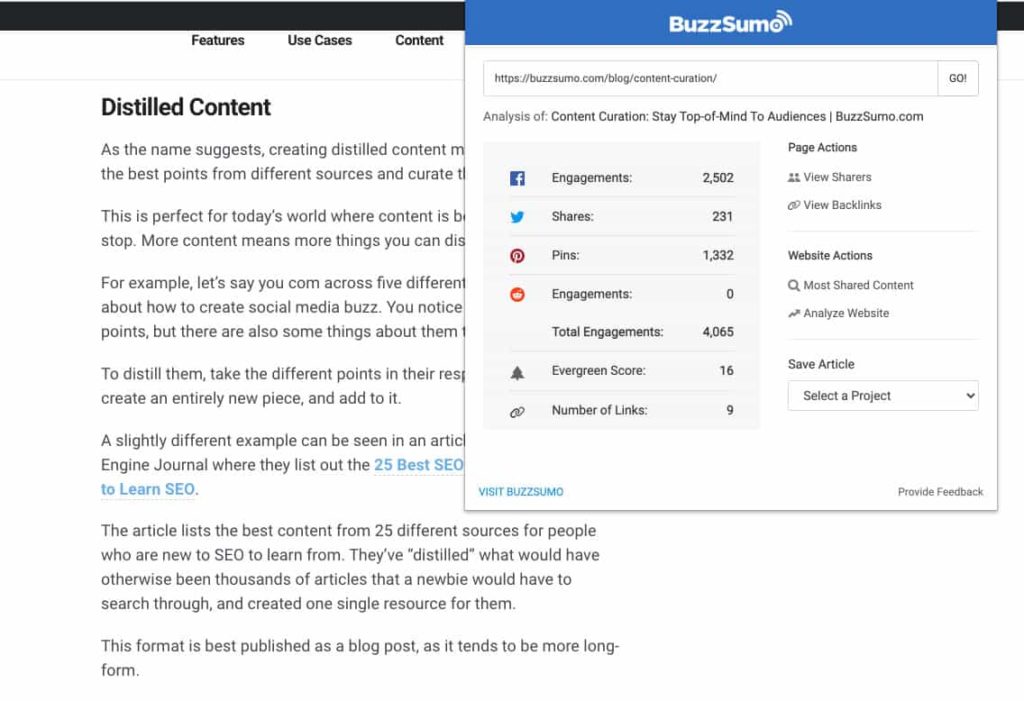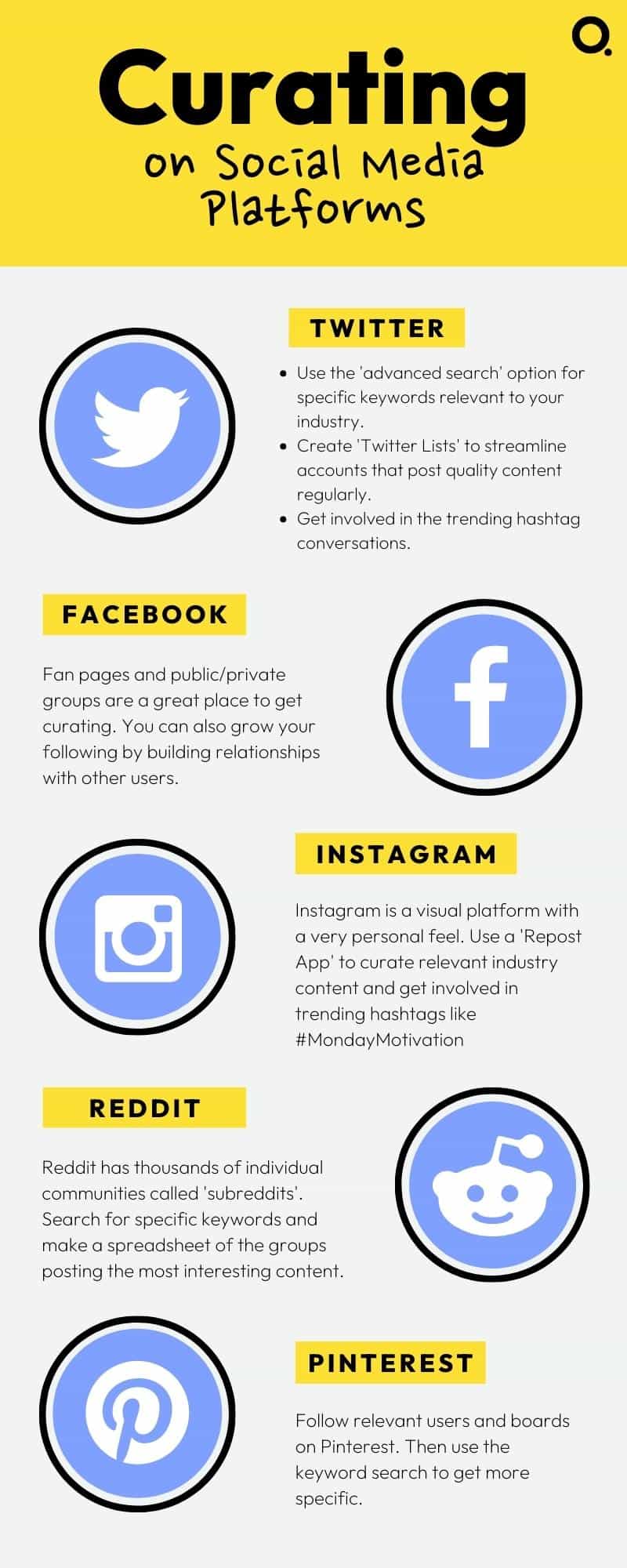Are you raising a family while working a full-time job? Trying to get through a college degree? Or do you just get to the end of the day and have no idea where the time went?
Modern life is busy. But social media is a powerful marketing tool. And audiences now expect brands to have a full content calendar to keep them satisfied. Knowing how to find content for social media can let you focus on other areas of your business. But most of the guides out there are long.
This is the TL;DR version you busy folk have been looking for. So, pick the section that fits you best and learn where to find social media content.
1. Content coffee break
If the only downtime you get in the day is your coffee break(s), some of the fastest content marketing tools are for you.
2. The lunchtime special
A sandwich in one hand and your laptop in the other. Your lunch hour is the optimal time for Tweeting and browsing great content. Check this out if you fancy some slightly more manual tools that still save a lot of time.
3. After work social media marketing
Tools are great. But you’ve got time on your hands after work and you’d like to get more involved. Finding quality content from ‘underground’ sources and social media sites can really pay off. Find out how.
4. Weekend warriors’ guide
You’ve got content curation down and fancy rolling up your sleeves to get creative. Fancy designing your own infographics? Repurposing old blogs? I’ll cover some of the easiest ways to produce new content (no graphic design experience required).
When it comes to social media management, the best strategy is variety. So try to use a combination of all of these strategies. If you’ve got time, read this whole blog and really take it in (hello SEO!) Joking aside, I promise it’ll all be handy.

Are you creating or curating?
Content creation (as the name might suggest) is creating original content and then marketing it to your target audience. And while it’s super important for SEO and building a following, it can be time-consuming.
This is where content curation comes in. Finding high-quality, shareable content from different sources and reposting it with a personal twist.
1. Content coffee break
If you’re looking for a digital marketing tool that stops you having to use a search engine until your fingers bleed, here are 3 of the most popular:
- BuzzSumo
- Quuu
The latest news and articles always make good content for social media. And one of the best features on Flipboard is the ability to create ‘Smart Magazines’.
You’re basically creating a content ‘playlist’ centered around a specific passion or niche. Once you’ve set it up, it’ll automatically update with similar suggestions. Meaning you’ll never miss a thing.
There are tons of specific topics to browse through, from travel to tech. You can make it public or private and invite others to get involved in group magazines.
BuzzSumo
BuzzSumo is a real all-rounder when it comes to content curation. From helping you discover new content from quality sources to identifying influencers in your industry. Plus, tracking the latest trending topics.
It’s one of the easiest ways to find valuable content for your social media calendar while keeping tabs on what your competitors are doing well (and not so well!)

By learning what your audience is searching for, you can find relevant content to share and put yourself ahead of most brands.
Quuu
Now, I realize this looks like a plug (and it is) but hear me out. The whole reason Quuu was invented was to help people save time when trying to curate content.
With over 500 interest categories, you’ll always have relevant content ideas to share with your audience on social media. This can be done manually or automatically, depending on the level of control you’d like to have.
Quuu also works with the most popular schedulers, so you can plan all your posts in advance. And make sure you’re always sharing high-quality content (even when you’re super busy.)

2. Social media lunchtime special
I’m sticking to tools here. However, these take a little more effort than the last three.
These are some of the most helpful for finding social media content. Including a wee summary and which social media platforms they work with.
| Tool | Summary | Social Media |
| Feedly | Feedly is almost like the ‘news feed of all news feeds’. Rounding up the best content for topics and categories that interest you. The more you use the platform, the more Leo (the handy, in-built AI research assistant) can tailor new content suggestions based on what you like. |
Facebook |
| Scoop.It | Part content curation, part social network. Scoop.it allows users to create boards and share content from a huge number of sources. Based on a newspaper-style format, the ‘scooped’ content explains how to improve future results based on campaign analytics. | Facebook |
| Hashtagify | From discovering trending topics to tracking insights to drive up engagement, hashtags are important. Hashtagify does all this and more—delving into the details of any hashtag you choose. | Twitter |
| Google Alerts | If you’d like to be notified whenever Google finds anything related to a specific search term, Google Alerts are the way to go. They take a little bit of time to set up. But once complete, your suggestions will be instant. They are a great way to keep ahead of the game on the latest topics in your industry. | Facebook |
| Tailwind | Instagram is slightly trickier, but Tailwind has some excellent tools to make life easier. Their Content Plans provide ready-to-use post ideas customized to your business. While also analyzing what’s working across your feed so you can see the type of content your followers enjoy. | |
| Ahrefs | If your goal is to rank higher and increase traffic to your site, Ahrefs’ Content Explorer is our go-to. Spanning over a billion web pages, it allows you to see the type of content performing well (so you can find more of the same.) | Facebook |
3. After work social media marketing
The majority of the content found by curation tools will be pretty popular. So, lots of brands will inevitably share the same thing.
Building yourself up to the position of a ‘thought leader’ in your industry is very possible. But it means finding alternative, high-quality content that few others are posting. Not the easiest task. Otherwise, everyone would be doing it.
Making a list of influential bloggers and subscribing to their email newsletters is another easy way to have content delivered straight to your inbox. But there’s gold to be found in social media platforms themselves.
Rather than another text-heavy section, I thought I’d make life a little easier. So here’s a handy infographic covering the most popular social media platforms. Plus, the under-used Reddit and subreddits.

4. Weekend warriors’ guide
If you’ve got time at the weekend, here’s some insight into the content creation side. If you’re not creative, don’t worry. There are lots of things you could focus on. Here are a few:
- Company website
- Infographics
- User-generated content
- Social campaigns/giveaways
Company website
Looking at your own company website or social media pages can provide a whole load of ideas for social posts. A photo from an event or an employee can turn into a stand-alone piece of content with the right copy behind it.
If you’d like to work on a larger piece of content, consider getting members of your company or experts together to host a webinar.

If you’ve already got a few blogs on your company website, why not try repurposing them? This means they’ll be seen by new audiences and take way less effort than writing new ones.
Infographics
The power of infographics can’t be disputed. And you don’t have to be a graphic designer to make your own, either.
Canva is a design platform that makes creating social media graphics, presentations, posters and other visual content. They have a Free and Pro version, both with drag-and-drop features and layouts to make designing simple. Plus, the Pro version is free if you happen to be a registered nonprofit.

If you make a high-quality infographic that you think lots of people will find helpful, why not submit it to Quuu Promote?
User-generated content (UGC)
This one is a bit of a cheat as you’re not having to come up with the bulk of the content yourself. By using a social listening tool (or even having a good old manual browse), you’ll be able to find images and posts customers have made showcasing your products or service.
Not only are you making the most of other people’s skills, you’re also highlighting that people value you enough to mention you.
Check out the below example from Buffer. The image has nothing to do with their business, but it’s been taken by one of their users. And who doesn’t like puppies?!

We all know the buzz of excitement when we realize we’ve been mentioned or shared on social media. Users who then retweet or repost your UGC could widen your audience amongst their followers too.
Social campaigns/giveaways
This is a big one in the current climate. Social causes always connect with people, but even more so nowadays. Even as a small business, choosing a campaign your brand can back (or even create one yourself) will give you a whole other area to focus your content on.
Stella Artois got a lot of praise by successfully driving awareness of the global water crisis when they paired with water.org. They sold signature chalice glasses to fund 5 years of clean water to someone in the developing world.

Giveaways are another great way of building buzz around your business or product. Offering freebies like products or trials can be a great way to spike engagement and traffic to your site. And (hopefully) increase conversions.
Conclusion
With a constant influx and battling against algorithms, finding content for social media can be tough. If you’re super busy, tools will be your best friend. But finding time (somewhere) for some manual curation will make sure you keep that human element.
Automation is really handy but you shouldn’t rely on it too much. Building a presence on social media comes from being present on the apps. Getting involved in conversations as they happen, engaging, and asking questions.
The above strategies are there for when you need them, though. So, you should always have something to post.
How do you find content for social media? Are there any obvious quick ways we’ve missed? Let us know in the comments below.





